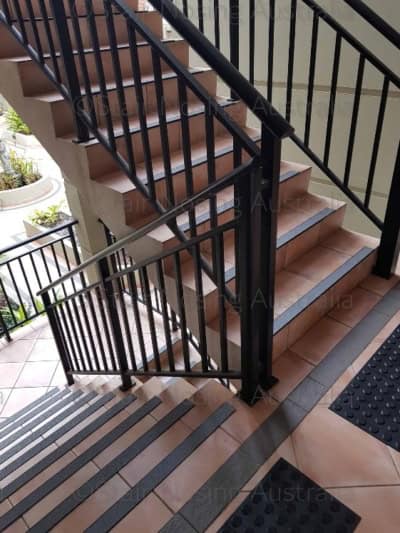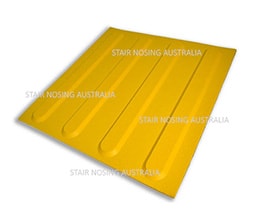Australian Stair Nosing Standards
What are the rules for stair nosing ?
BCA Rules and Compliance
There is much discussion around the what are the rules for stair nosing. Australian stair nosing standards and BCA rules and compliance for stairs. Luminance contrast for stair nosing also needs to be explained.
I have created an easy to use FLIP Book, whereby you can flip the pages and read all the information about the 2021 July Revision of the Australian Stair Nosing Standards
The Flipbook includes high resolution images and videos.
Australian Stair Nosing Standards
If you are the owner of the property and it is your home, then you do not require stair nosing. It is a personal choice.
If you are a developer of residential apartments then yes you do need to have stair nosing on steps. If you run a BNB you do require stair nosing.
An important point to note is that the Premises Standards will only apply to new buildings and new work (renovations) on existing buildings, on or after the 1st May 2011. The Premises Standards includes the Access Codes 1428.1
The legislation drafted in 2009 but enforced in May 1st 2011, was not retrospective, and only applied to NEW BUILDING WORKS on or after the 1st May 2011
In any commercial development or residential apartment development all stairs must have stair nosing and tactiles.
If you are an owner builder, or you own your home, then you do not require stair nosing. It is a worthy idea to install stair nosing for your own and your guests safety.
If you own a Air B&B you do have to have stair nosings, as it becomes public access.
If your building was built after May 1st 2010 you MUST comply with the current AS1428 standards outlined in the Premises Standard which comes under the DDA act enforced by the Government in 1992.
What are the rules for stair nosing ?
Yes, if your building has public access you must have stair nosing and Tactiles to comply with Building Codes of Australia (BCA) regulations.
The Disability (Access to Premises – buildings) Standards 2010 (the Premises Standards) commenced on 1 May 2011.
An important point to note is that the Premises Standards will only apply to new buildings and new work (renovations) on existing buildings. An existing building not undergoing any new work will still be subject to the current complaint’s mechanisms of the law.
If I my building was built prior to 2009 do I have to install stair nosings?
2009- Australian Standard 1428.1
Draft Disability (Access to Premises – Buildings) Standards 2009 was released. This was the primary document that would eventually form the Premises Standards.
- Part 1. The first part deals with all the regulation requirements for the Premises Standards
- Part 2. Schedule 1 Access Code for Buildings.
This Access Code tells those responsible for buildings when and where access is required and then refers to technical specification documents such as Australian Standard 1428.1 to describe how to design and build in an accessible way.
An important point to note is that the Premises Standards will only apply to new buildings and new work (renovations) on existing buildings, on or after the 1st May 2011
The legislation drafted in 2009 but enforced in May 1st 2011, was not retrospective, and only applied to NEW BUILDING WORKS on or after the 1st May 2011
BCA Rules and Compliance
Opaque risers means that we cannot see through the steps. The image below shows a set of steps where they don’t have opaque risers, in other words you can see through them.
The reason for this is that the light behind the stairs is different to the light that is reflected on the stair tread (where you put your foot). This means that it can alter your perception of where to place your foot safely on the step.
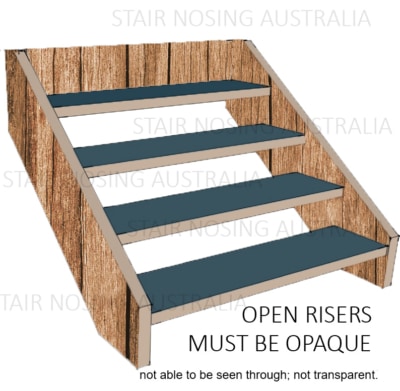
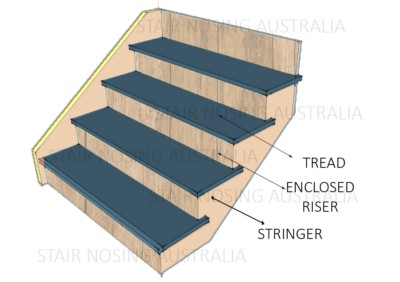
Australian stair nosing standards Design for Access and Mobility
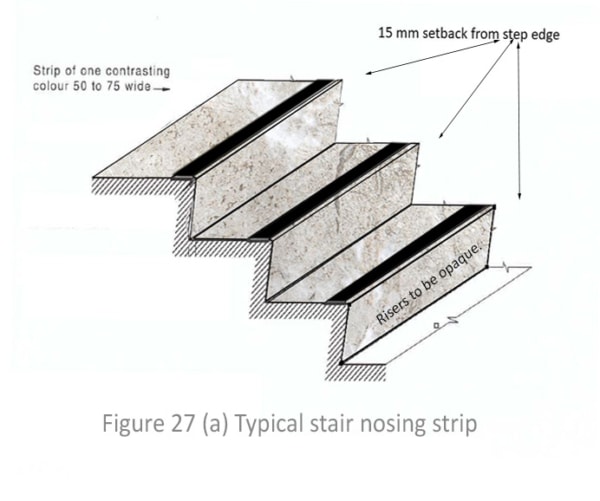
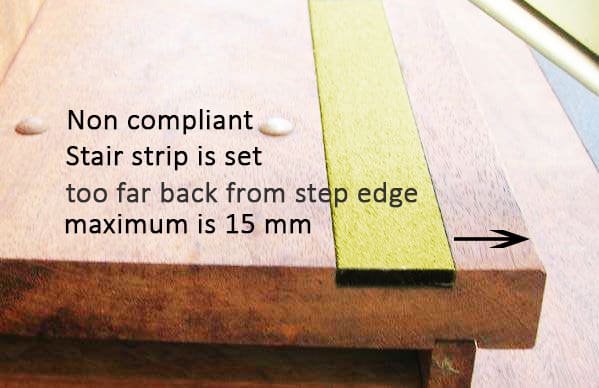
11. STAIRWAYS
11.1 Stair Construction (f)
(f) At the nosing, each tread shall have a strip not less than 50 mm and not more than 75 mm deep across the full width of the “path of travel, where the pedestrian walks, NOT wall to wall.
What is meant by the full path of travel?
The Path of travel that we talk about relates to “Continuous Path of Travel ” access for the disabled from car parks, up ramps, into buildings etc. SAI Global standards, that it does not apply to steps.
Stair nosing must be installed the full width of the step where pedestrian traffic will traverse the steps.
(f)In the 2021 standards it states that the nosing, each tread shall have a strip not less than 50 mm and not more than 75 mm deep across the full width of the path of travel NOT across the full width of the step.
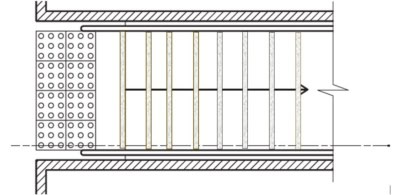 The area of the tread that is not obstructed (by a handrail or similar) and therefore part of the path when travelling on the stair = The path of travel.
The area of the tread that is not obstructed (by a handrail or similar) and therefore part of the path when travelling on the stair = The path of travel.Clearly the stair nosing must be installed where the pedestrian will place their foot; it would certainly not be 50 mm form the balustrade.
Additionally, the base plates of the balustrade did not interfere with the path of travel. Commonsense must prevail.
Some people choose to install stair nosing leaving a gap on each side. When installing stair nosing on soft floor finishes such as carpet; in the majority of cases the nosings will be installed “wall to wall”.
Luminance Contrast Values (LRV)
Reflectance is the proportion of light that a surface reflects compared to the amount of light that falls on the surface.
An LRV is a value given to a surface to denote the amount of light reflected.
LRVs are marked on a scale of 1 to 100 depending on the percentage of light reflected. Dark, matt and/or textured surfaces absorb a large amount of light and, therefore, have low reflectance values.
On the other hand, light, glossy and/or smooth surfaces reflect the majority of light that falls on them and have high reflectance values.
For example, a colour with an LRV of 60 (which means it reflects 60% of the light that falls on it) will reflect more light than that of a colour with an LRV of 30.
The Australian Standards for stair nosing form part of a larger group of regulations governing stairway construction, use of Tactile indicators, balustrades and exit signage.
The latest release of this standard is AS1428 2021 Design for Access and Mobility. The previous release was in 2009 although some changes have been made in more recent revisions such as in 2012.
It is important to note that some of the revised standards published in 2021 are yet to be mandated or adopted by the Building Codes of Australia.
How does this affect you? If the changes in the current document affect you in ways that you would prefer to go by the AS1428 2009 standards then you can.
It seems bizarre to publish a set of standards and have the BCA yet to adopt them. Never the less it is common sense, abide by the current standards and when the BCA adopt and mandate them, then you will comply.
Rises and goings:
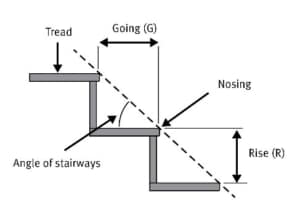 Design requirements for stairs and steps
Design requirements for stairs and steps
All risers and goings on the same flight of stairs should have uniform dimensions within a tolerance of ±5 mm.
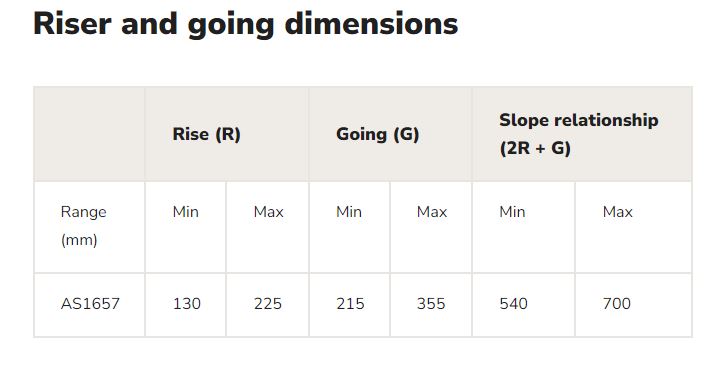
11. Stairways
11.1 Stairway Construction (d) and (e)
(d and e) The riser may be vertical or splay backwards up to a maximum 25 mm.
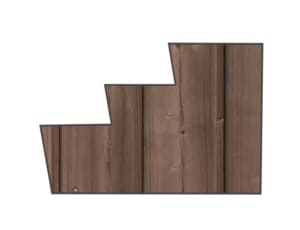
This is to ensure that when pedestrians traverse the steps they do not get their foot caught underneath the “going” or “tread” of the step. Example of a splayed stair nosing.
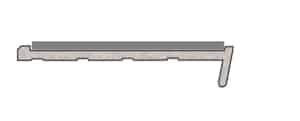
(d and e) The riser may be vertical or splay backwards up to a maximum 25 mm.
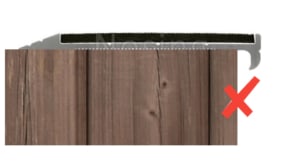 Stair Nosings shall NOT project beyond the face of the riser.
Stair Nosings shall NOT project beyond the face of the riser.

EXAMPLE OF A NOSING WITH A SHARP EDGE
(i) have a sharp intersection.
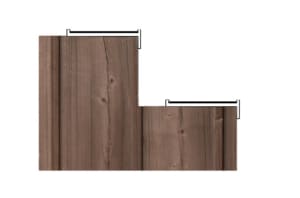
(ii) be rounded up to a 5 mm radius..
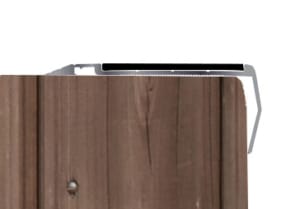
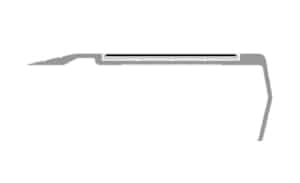
(iii) be chamfered up to 5 mm × 5 mm.
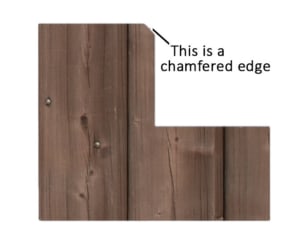
In 1992 the Commonwealth Government passed the DDA ACT (11 years after The United Nations Year of Disabled Persons.)
As a result of that ACT in 1992 one standard that was introduced was the AS1428 Design for Access and Mobility Standards
Disability Discrimination Act 1992
When were the AS1428 Design for Access and Mobility Standards come into force and when do we need to comply?
History
1976
In 1976, the General Assembly of The United Nations proclaimed 1981 as the International Year of Disabled Persons.
1981
Commonwealth Disability Discrimination Act (DDA) 1992, was enacted after the United Nations l Year of Disabled Persons in 1981.
What is DDA Disability Discrimination Act?
Disability Discrimination Act 1992
The DDA ACT was introduced in 1992 .
The DDA act issued a range of standards and they were called the “Premises standards”
The Government asked for consultations to draft up a set of what was called Premises Standards and report this to Parliament and they had to report this to first half of 2009.
Draft Disability (Access to Premises – Buildings) Standards 2009 released. This was the primary document that will eventually form the Premises Standards.
One standard that was introduced in DDA Act was the AS1428 Design for Access and Mobility Standards.


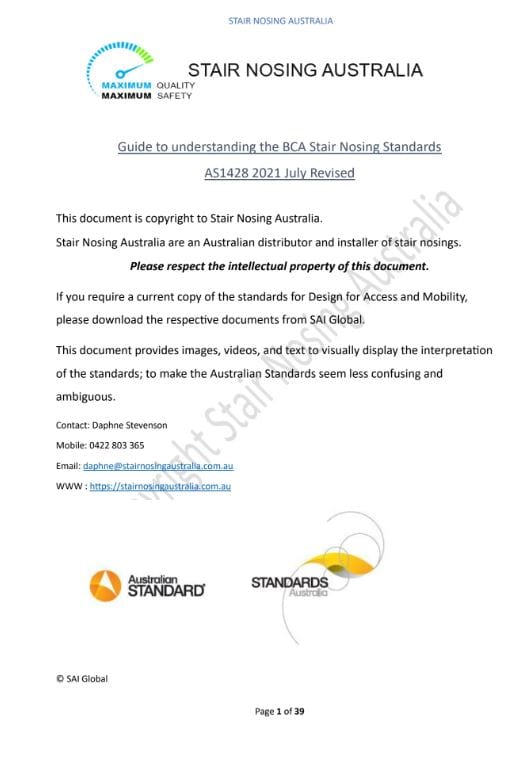
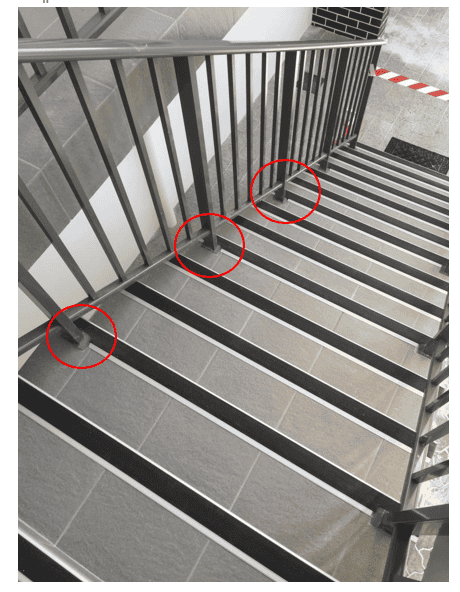 In this picture the client wanted the stair nosing to be install across the entire tread of the step.
In this picture the client wanted the stair nosing to be install across the entire tread of the step.
